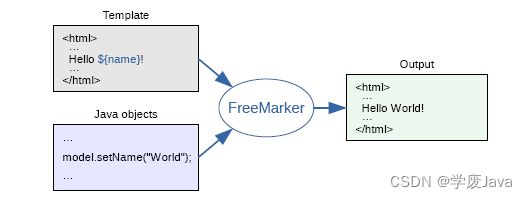Freemarker从0到1深入讲解
文章目录
- Freemarker
- 入门案例
-
- 依赖
- 配置文件
- 案例:
- freemarker基础
-
- 基础语法种类
- 集合指令(List和Map)
- if指令(判断)
- Freemarker运算符
- 空值处理
- 内建函数
- 静态化测试
Freemarker
-
FreeMarker 是一款 模板引擎: 即一种基于模板和要改变的数据, 并用来生成输出文本(HTML网页,电子邮件,配置文件,源代码等)的通用工具。 它不是面向最终用户的,而是一个Java类库,是一款程序员可以嵌入他们所开发产品的组件。
-
模板编写为FreeMarker Template Language (FTL)。它是简单的,专用的语言, 不是 像PHP那样成熟的编程语言。 那就意味着要准备数据在真实编程语言中来显示,比如数据库查询和业务运算, 之后模板显示已经准备好的数据。在模板中,你可以专注于如何展现数据, 而在模板之外可以专注于要展示什么数据。

常用的java模板引擎还有哪些?
Jsp、Freemarker、Thymeleaf 、Velocity 等。
1.Jsp 为 Servlet 专用,不能单独进行使用。
2.Thymeleaf 为新技术,功能较为强大,但是执行的效率比较低。
3.Velocity从2010年更新完 2.0 版本后,便没有在更新。Spring Boot 官方在 1.4 版本后对此也不在支持,虽然 Velocity 在 2017 年版本得到迭代,但为时已晚。
入门案例
依赖
<dependency>
<groupId>org.springframework.bootgroupId>
<artifactId>spring-boot-starter-freemarkerartifactId>
dependency>
<dependency>
<groupId>org.apache.commonsgroupId>
<artifactId>commons-ioartifactId>
<version>1.3.2version>
dependency>
配置文件
server:
port: 8881 #服务端口
spring:
application:
name: freemarker-demo #指定服务名
freemarker:
cache: false #关闭模板缓存,方便测试
settings:
template_update_delay: 0 #检查模板更新延迟时间,设置为0表示立即检查,如果时间大于0会有缓存不方便进行模板测试
suffix: .ftl #指定Freemarker模板文件的后缀名
案例:
- 创建一个Student类
@Data
public class Student {
private String name;//姓名
private int age;//年龄
}
- 创建模板
- 在
resources下创建templates - 在 templates下创建模板文件
01-basic.ftl
- 在
DOCTYPE html>
<html>
<head>
<meta charset="utf-8">
<title>Hello World!title>
head>
<body>
<b>普通文本 String 展示:b><br><br>
Hello ${name} <br>
<hr>
<b>对象Student中的数据展示:b><br/>
姓名:${stu.name}<br/>
年龄:${stu.age}
<hr>
body>
html>
- 创建controller
@Controller
public class HelloController {
@GetMapping("/basic")
public String test(Model model) {
//1.纯文本形式的参数
model.addAttribute("name", "freemarker");
//2.实体类相关的参数
Student student = new Student();
student.setName("小明");
student.setAge(18);
model.addAttribute("stu", student);
return "01-basic";
}
}
- 启动类
import org.springframework.boot.SpringApplication;
import org.springframework.boot.autoconfigure.SpringBootApplication;
@SpringBootApplication
public class FreemarkerDemotApplication {
public static void main(String[] args) {
SpringApplication.run(FreemarkerDemotApplication.class,args);
}
}
freemarker基础
基础语法种类
1、注释,即<#-- -->,介于其之间的内容会被freemarker忽略
<#--我是一个freemarker注释-->
2、插值(Interpolation):即 . . 部分 , f r e e m a r k e r 会用真实的值代替 {..} 部分,freemarker会用真实的值代替 ..部分,freemarker会用真实的值代替{…}
Hello ${name}
3、FTL指令:和HTML标记类似,名字前加#予以区分,Freemarker会解析标签中的表达式或逻辑。
<# >FTL指令
4、文本,仅文本信息,这些不是freemarker的注释、插值、FTL指令的内容会被freemarker忽略解析,直接输出内容。
<#--freemarker中的普通文本-->
我是一个普通的文本
集合指令(List和Map)
$ <#list model里面的名 as 变量名>
Student stu2 = new Student();
stu2.setName("小红");
//将两个对象模型数据存放到List集合中
List<Student> stus = new ArrayList<>();
stus.add(stu1);
//向model中存放List集合数据
model.addAttribute("stus",stus);
<#list stus as stu>
<tr>
<td>${stu_index+1}td>
<td>${stu.name}td>
tr>
#list>
${stt_index}:h获取下标,默认是0开始
- Map
HashMap<String,Student> stuMap = new HashMap<>();
stuMap.put("stu1",stu1);
stuMap.put("stu2",stu2);
// 3.1 向model中存放Map数据
model.addAttribute("stuMap", stuMap);
<a href="###">方式一:通过map['keyname'].propertya><br/>
输出stu1的学生信息:<br/>
姓名${stuMap['stu1'].name}<br/>
年龄${stuMap['stu1'].age}<br/>
<br/>
<a href="###">方式二:通过map.keyname.propertya><br/>
输出stu2的学生信息:<br/>
姓名:${stuMap.stu2.name}<br/>
年龄:${stuMap.stu2.age}<br/>
- 遍历Map
<a href="###">遍历map中两个学生信息:a><br/>
<table>
<tr>
<td>序号td>
<td>姓名td>
<td>年龄td>
<td>钱包td>
tr>
<#list stuMap?keys as key >
<tr>
<td>${key_index}td>
<td>${stuMap[key].name}td>
<td>${stuMap[key].age}td>
<td>${stuMap[key].money}td>
tr>
#list>
table>
- 总结
- 获取Map
map['keyname'].property
map.keyname.property - 遍历Map
<#list userMap?key as key>
${stuMap[key].name}
#list>
if指令(判断)
<#if >
<#else>
#if>
- 要求让list集合中’小红’的数据字体为红色
<#list stus as stu >
<#if stu.name='小红'>
<tr style="color: red">
<td>${stu_index}td>
<td>${stu.name}td>
<td>${stu.age}td>
<td>${stu.money}td>
tr>
<#else >
<tr>
<td>${stu_index}td>
<td>${stu.name}td>
<td>${stu.age}td>
<td>${stu.money}td>
tr>
#if>
#list>
- 注意 =号和==是一样的使用
Freemarker运算符
FreeMarker表达式中完全支持算术运算,FreeMarker支持的算术运算符包括:
- 数学运算符
- 加法: +
- 减法: -
- 乘法: *
- 除法: /
- 求模 (求余): %
- 比较运算符
- =或者==:判断两个值是否相等.
- !=:判断两个值是否不等.
>或者gt:判断左边值是否大于右边值>=或者gte:判断左边值是否大于等于右边值- <或者lt:判断左边值是否小于右边值
- <=或者lte:判断左边值是否小于等于右边值
比较运算符注意
- =和!=可以用于字符串、数值和日期来比较是否相等
- =和!=两边必须是相同类型的值,否则会产生错误
- 字符串 “x” 、"x " 、"X"比较是不等的.因为FreeMarker是精确比较
- 其它的运行符可以作用于数字和日期,但不能作用于字符串
- 使用gt等字母运算符代替>会有更好的效果,因为 FreeMarker会把>解释成FTL标签的结束字符
- 可以使用括号来避免这种情况,如:<#if (x>y)>
- 逻辑运算符
- 逻辑与:&&
- 逻辑或:||
- 逻辑非:!
空值处理
- 空值处理
判断某变量是否存在使用 “??”
<#if stus??>
<#list stus as stu>
......
#list>
#if>
- 缺失变量默认值使用 “!”
-
使用!要以指定一个默认值,当变量为空时显示默认值
例: ${name!‘’}表示如果name为空显示空字符串。俩个单引号表示空 -
如果是嵌套对象则建议使用()括起来
例: ${(stu.name)!‘’}表示,如果stu或bestFriend或name为空默认显示空字符串。
内建函数
- 内建函数语法格式:
变量+?+函数名称
- 和到某个集合的大小
${集合名?size} - 日期格式化:
- 显示年月日:
${today?date} - 显示时分秒:${today?time}
- 显示日期+时间:${today?datetime}
- 自定义格式化: ${today?string(“yyyy年MM月”)}
- 显示年月日:
- 函数c
model.addAttribute("point",11223344556)`
${point} 显示效果为:112,223,334,556
${point?c} 显示效果为:11223344556
4. 将JSON字符串转成对象 eval
<#assign text="{'bank':'工商银行','account':'10101920201920212'}" />
<#assign data=text?eval />
开户行:${data.bank} 账号:${data.account}
静态化测试
server:
port: 8881 #服务端口
spring:
application:
name: freemarker-demo #指定服务名
freemarker:
cache: false #关闭模板缓存,方便测试
settings:
template_update_delay: 0 #检查模板更新延迟时间,设置为0表示立即检查,如果时间大于0会有缓存不方便进行模板测试
suffix: .ftl #指定Freemarker模板文件的后缀名
template-loader-path: classpath:/templates #获取
- xxx.ftl
DOCTYPE html>
<html>
<head>
<meta charset="utf-8">
<title>Hello World!title>
head>
<body>
<#-- list 数据的展示 -->
<b>展示list中的stu数据:b>
<br>
<br>
<table>
<tr>
<td>姓名td>
<td>年龄td>
<td>钱包td>
tr>
<#list stus as stu >
<#if stu.name='小红'>
<tr style="color: red">
<td>${stu_index}td>
<td>${stu.name}td>
<td>${stu.age}td>
<td>${stu.money}td>
tr>
<#else >
<tr>
<td>${stu_index}td>
<td>${stu.name}td>
<td>${stu.age}td>
<td>${stu.money}td>
tr>
#if>
#list>
table>
<hr>
<#-- Map 数据的展示 -->
<b>map数据的展示:b>
<br/><br/>
<a href="###">方式一:通过map['keyname'].propertya><br/>
输出stu1的学生信息:<br/>
姓名${stuMap['stu1'].name}<br/>
年龄${stuMap['stu1'].age}<br/>
<br/>
<a href="###">方式二:通过map.keyname.propertya><br/>
输出stu2的学生信息:<br/>
姓名:${stuMap.stu2.name}<br/>
年龄:${stuMap.stu2.age}<br/>
<br/>
<a href="###">遍历map中两个学生信息:a><br/>
<table>
<tr>
<td>序号td>
<td>姓名td>
<td>年龄td>
<td>钱包td>
tr>
<#list stuMap?keys as key >
<tr>
<td>${key_index}td>
<td>${stuMap[key].name}td>
<td>${stuMap[key].age}td>
<td>${stuMap[key].money}td>
tr>
#list>
table>
<hr>
body>
html>
- 测试
@SpringBootTest(classes = FreemarkerDemoApplication.class)
@RunWith(SpringRunner.class)
public class FreemarkerTest {
@Autowired
private Configuration configuration;
@Test
public void test() throws IOException, TemplateException {
Template template = configuration.getTemplate("02-list.ftl");
/**
* 第一个参数: 模型数据
* 第二个参数: 输出流
*/
template.process(getData(),new FileWriter("e:/list.html"));
}
private Map getData() {
Map<String, Object> map = new HashMap<>();
//小强对象模型数据
Student stu1 = new Student();
stu1.setName("小强");
stu1.setAge(18);
stu1.setMoney(1000.86f);
stu1.setBirthday(new Date());
//小红对象模型数据
Student stu2 = new Student();
stu2.setName("小红");
stu2.setMoney(200.1f);
stu2.setAge(19);
//将两个对象模型数据存放到List集合中
List<Student> stus = new ArrayList<>();
stus.add(stu1);
stus.add(stu2);
//向map中存放List集合数据
map.put("stus", stus);
//创建Map数据
HashMap<String, Student> stuMap = new HashMap<>();
stuMap.put("stu1", stu1);
stuMap.put("stu2", stu2);
//向map中存放Map数据
map.put("stuMap", stuMap);
//返回Map
return map;
}
}

